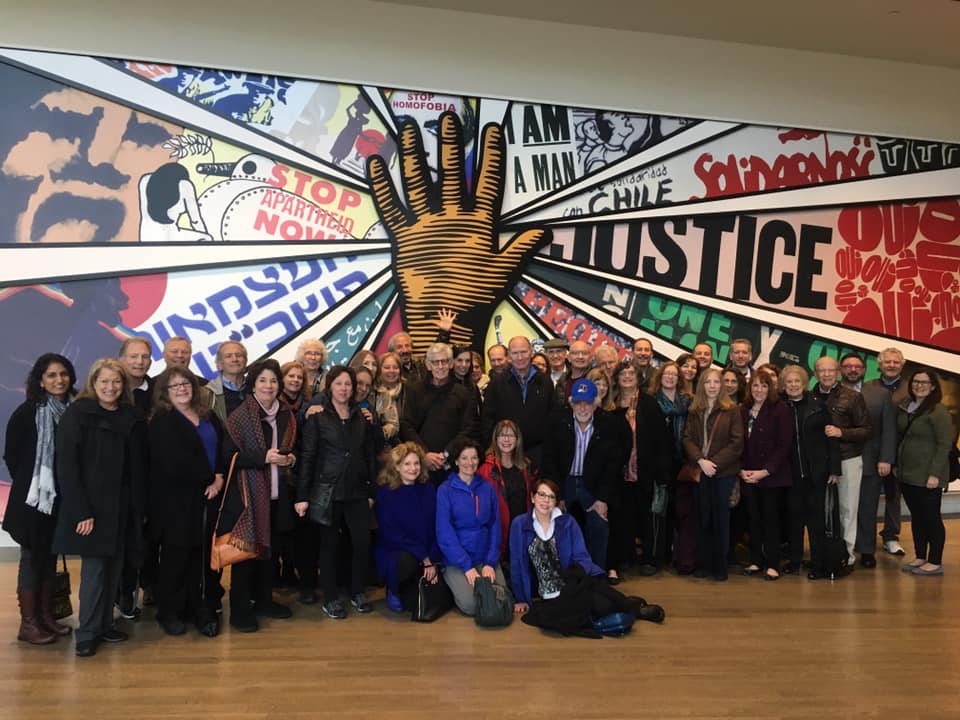
ADL Mountain States Delegation at Atlanta Center for Civil and Human Rights
This month, the ADL Mountain States Region was host to 44 participants that journeyed to the American South on a Civil Rights Mission to historical sites in Georgia and Alabama. Beginning in Atlanta and continuing on to Montgomery, Selma and Birmingham, the group visited several locations to learn more about slavery, the civil rights movement and current activism aimed at supporting the African-American community, combating voter suppression and more.
The trip was covered by Colorado Public Radio reporter Anthony Cotton in “Marching With King: After 50 Years, A Coloradan Makes An Emotional Return To Selma”.
Stops included Ebenezer Baptist Church, the National Civil and Human Rights Museum and Fair Fight 2020 in Atlanta, the Rosa Parks Museum, the Equal Justice Initiative Legacy Museum and the National Memorial for Peace and Justice (the Lynching Memorial) in Montgomery, the Edmund Pettus Bridge in Selma and the 16th Street Baptist Church and the Birmingham Civil Rights Institute in Birmingham. Participants also met with civil rights leaders Joanne Bland, who was arrested at the age of 11 on Bloody Sunday in 1965, when people attempted to march from Selma to Montgomery in support of voting rights, and Bishop Calvin Woods, who was the last person to see Dr. Martin Luther King, Jr. alive in Montgomery the night before his murder.
Former ADL Regional Director and Honorary Regional Board Member Sheldon “Shelly” Steinhauser joined the trip as scholar-in-residence. Shelly spoke with the group about his experiences as an ADL Regional Director marching with Dr. King 55 years ago alongside a delegation of 100 Colorado community members that had flown to Montgomery to participate in the last several miles of the 1965 march. Rabbi Steven Foster, Rabbi Emeritus of Temple Emanuel, also spoke about his experience as a college student on the march.
In reflecting on that time, Shelly writes:
When we arrived at the encampment, we went back to where Dr. King and several of his associates were sitting alone. We shook his hand and thanked him profusely for his courage and moral leadership. And in a quiet, humble voice, he thanked us for the support we and so many others were providing to the African American community. After almost no sleep, we joined the other marchers and walked slowly into the area of the State Capitol. On the way in, we passed by homes of African Americans, men, women and children, who came out on their porches and even into the street and brought us water and food because they knew then what we found out after – that all the water spigots in downtown Montgomery near our route had been turned off to deny us water. We stood together at the State Capitol, black and white, Christians and Jews – so many Jews — including Martin Luther King’s close friend, Rabbi Abraham Joshua Heschel, who joined us and walked arm in arm with Dr. King. And we stood and listened to Dr. King’s powerful and eloquent remarks, even as we were silently stared at by dozens of locals from the balconies of office buildings surrounding the Capitol square, men and women with some of the most hateful stares I had ever witnessed. After the march, Rabbi Heschel said the feeling was so powerful he felt like he was praying with his feet.
ADL Mountain States Regional Director Scott L. Levin says:
The Civil Rights Mission to the South demonstrated ADL’s commitment to a mission that not only fights to stop anti-Semitism, but also seeks to secure justice and fair treatment for all. We were so fortunate to be joined on this trip by my tremendous predecessor Shelly Steinhauser and by Rabbi Steven Foster. It was evident that their experiences in having joined Dr. King and so many others on the march into Montgomery in 1965 was instrumental to their leadership for so many years in the fight for civil rights in Colorado.

